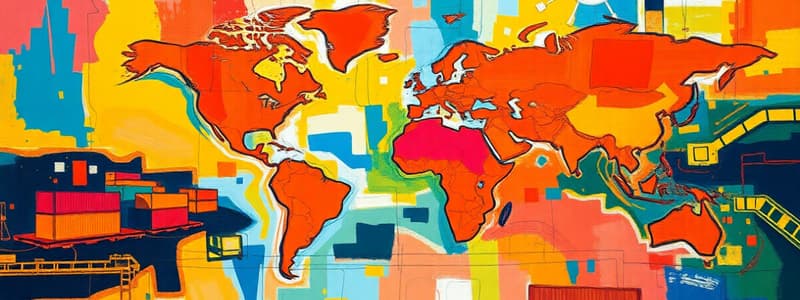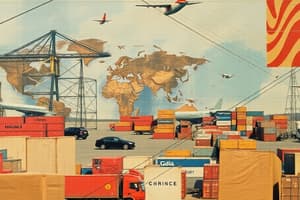Podcast
Questions and Answers
Compare and contrast origin and deconsolidation hubs, detailing how they cater to different logistical needs within the supply chain.
Compare and contrast origin and deconsolidation hubs, detailing how they cater to different logistical needs within the supply chain.
Origin hubs consolidate goods from multiple suppliers for efficient shipping, while deconsolidation hubs break down bulk shipments for distribution to multiple consignees. Origin hubs optimize outbound logistics, deconsolidation hubs optimize inbound distribution.
Analyze how the establishment of a Bonded Logistics Park (BLP) in China can streamline international trade operations for businesses, considering VAT and customs procedures.
Analyze how the establishment of a Bonded Logistics Park (BLP) in China can streamline international trade operations for businesses, considering VAT and customs procedures.
A BLP in China enables businesses to consolidate cargo from various suppliers, defer VAT payments until goods are sold, and streamline customs procedures, reducing lead times and improving cash flow.
Discuss the benefits and risks involved in utilizing a Multi-Country Consolidation (MCC) hub in Taiwan, focusing on its impact on cost efficiency and market expansion.
Discuss the benefits and risks involved in utilizing a Multi-Country Consolidation (MCC) hub in Taiwan, focusing on its impact on cost efficiency and market expansion.
Benefits of an MCC hub include cost savings from optimized container utilization and support for market expansion by efficiently distributing goods to smaller markets. Risks involve potential complexities in managing inventory and compliance across multiple countries.
Explain how the selection of a Regional Distribution Center (RDC) location can be influenced by Free Trade Agreements (FTAs) and the impact this has on overall supply chain efficiency.
Explain how the selection of a Regional Distribution Center (RDC) location can be influenced by Free Trade Agreements (FTAs) and the impact this has on overall supply chain efficiency.
Illustrate how implementing a ‘Many to Many’ hub model can optimize Less than Container Load (LCL) shipments in a complex international supply chain network.
Illustrate how implementing a ‘Many to Many’ hub model can optimize Less than Container Load (LCL) shipments in a complex international supply chain network.
Flashcards
What are International Hubs?
What are International Hubs?
A facility or location that serves as a central point for coordinating and streamlining the flow of goods in a supply chain, supporting various transportation methods. Hubs can be at the country or provincial level.
Many to One
Many to One
Cargo from many suppliers is delivered to a central consolidation center, then loaded into a full container (FCL) and shipped to its final destination. The container seal remains unopened until it reaches the final destination warehouse.
What is a Bonded Logistics Park (BLP)?
What is a Bonded Logistics Park (BLP)?
A bonded logistics park in China that consolidates cargo from Chinese and overseas suppliers to be stored and redistributed to overseas markets upon final customer orders.
Multi-Country Consolidation Hub (MCC)
Multi-Country Consolidation Hub (MCC)
Signup and view all the flashcards
Regional Distribution Center (RDC)
Regional Distribution Center (RDC)
Signup and view all the flashcards
Study Notes
International Hubs
- Hubs have different meanings based on context
- At the country or provincial level, hubs can refer to global logistics or ecommerce centers
- Focus is on international hubs as facilities within the international logistics flow
- This discussion contrasts international hubs with domestic ones
International Hub Locations
- International hubs can be found at various points in the supply chain
- These include:
- Origin Hubs
- GDC, RDC and MCC Hubs
- Decon Centres
- Domestic Hubs and Warehouses
Hub Enabled Transportation Methods
- Hubs facilitate different transportation models:
- 1 to 1
- 1 to many
- Many to 1
- Many to many
1 to 1 Transportation
- One supplier location ships directly to one consignee location
- Involves various modes like Ocean FCL, Airfreight, Rail FCL, and Road X-border
- It can also use Intermodal
1 to Many Transportation
- Focus on destination deconsolidation centers
- One supplier loads a Full Container Load (FCL)
- The FCL ships to a decon center for breakbulk
- Cargo is then cross-docked into multiple box trucks for delivery to multiple destination warehouses
- Multiple "1 to many" flows converging at the decon center adds efficiency through cross-docking
Many to 1 Transportation
- Origin consolidation hubs consolidate cargo from multiple suppliers
- Suppliers deliver cargo by truckloads to a consol center
- Cargo is planned and consolidated into an FCL destined for the same final destination warehouse, without opening the container until final destination
- E2E planning is required
- Activities at origin hub include cross-docking (short dwell) and storage (long dwell)
Bonded Logistics Park (BLP) in China
- Positions itself as an international hub
- Aims to consolidate cargo from Chinese and overseas suppliers
- Stores and redistributes cargo to overseas markets based on final customer orders
- Cargo entering BLPs receives immediate VAT refunds or is bonded
- China's BLP is differentiated from HK or Singapore
BLP Goals and Locations
- Chinese government aims to attract international goods flows
- Goal is to build China's international ocean freight hubs
- BLPs serve the logistics needs of multinational corporations
- They handle transshipment, supply of products, and international trade activities
- BLPs are established in coastal cities of China, including:
- Dayaowan (Dalian)
- Tianjin & Dongjian
- Qianwan (Qingdao)
- Zhangjiagang
- WGQ & Yangshan (Shanghai)
- Guangzhou & Nansha
- Fuzhou
- Xiangyu & Haicang (Xiamen)
- Yantian & Qianhaiwan (Shenzhen)
Waigaoqiao BLP in Shanghai
- A 1.02 sq KM space allocated
- Established in April 2004
- Offers 278,300 sqm of warehouse space
- Key areas are 40-60 minutes from airports
- Major customers: HP, Acer, SIEMENS
- Various major verticals
Many to Many Transportation
- Involves multi-country consolidation (MCC) through an international mixing hub
- Many suppliers and consignees are in the network with small volumes from each supplier
- Cargo is shipped "many-to-many" instead of holding it at the CFS
- Direct ocean from origin to destination post is possible
- Transloading at a transhipment hub for re-mixing is also facilitated
Case study: MCC in Taiwan
- A US brand uses MCC in Taiwan for cost-efficient distribution to smaller and new sales countries
- The brand manufactures apparel, footwear, and sport equipment
- Origins include China, Vietnam, Indonesia, India, and Thailand
- It extends to the rest of the Americas
- Mixing Hub in Kaohsiung since 2010 supports the customer's expansion
Regional Distribution Centre (RDC)
- Involves inventory holding, value-added services and longer dwell times
- Offers optimized container utilization and diverting of small cargo flow (LCL/Air/Road)
RDC used by audio equipment company in Shenzhen
- Used by American company manufacturing audio equipment
- Aims to have better inventory management
- Improves distribution strategy
- Intends to centralize VAS at origin for cost efficiencies
Impact of Hubs on Transportation Management
- Origin hubs/BLPs/MCCs reduce LCL/LTL
- Such hubs enable buyers to buy small order sizes
- This avoids high transport costs due to consolidation
- RDCs/GDCs leverage multi-mode transportation
- Instead of long haul air you can pull from regional hub using ocean
- Ability to deploy most appropriate transport method depending on inventory needs
Considerations for RDC Location
- Choosing a location for a Regional Distribution Center (RDC) is vital
- Free Trade Agreements (FTA) play a key role in influencing the decision
- Singapore is more attractive
- It is part of the ASEAN & ASEAN+1 FTA, offering potential tax benefits
FTA and Hub Choice
- FTA savings impact the hub and transport choice
- Transportation department needs trade compliance input
- The goal is a holistic logistics strategy
- Depending on the incoterm, the shipper/consignee may or may not gain the import duty savings
- Adding the seller or buyer increases decision complexity
Studying That Suits You
Use AI to generate personalized quizzes and flashcards to suit your learning preferences.





